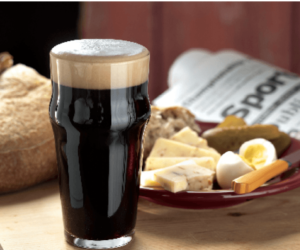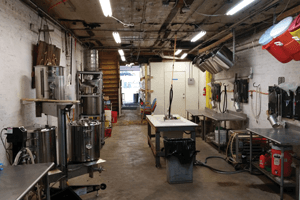Milwaukee Brewing Co.’s Louie’s Demise Ale: Replicator
Dear Replicator,
My neighbor and brewing buddy, David Toomes, was visiting relatives in Wauwatosa, Wisconsin a couple of months ago. He texted me to say he had found a beer he just raved about. I told him to bring back a six pack and we would see if we could brew it. That beer was “Louie’s Demise” from Milwaukee Brewing Company. It’s amber, well balanced, and very complex. That makes it tough to figure out how to duplicate. I’m hoping you can help us figure it out.
Chuck Miles
St. Louis, Missouri
hen Jim McCabe, Milwaukee Brewing Company’s owner, arrived at Marquette University he became enamored with the deeply rooted beer culture of the city. This was much different from his hometown of Buffalo, New York. Virtually every neighborhood had two or more taverns where the locals would gather for Milwaukee-produced beer and casual conversation. The beers that were offered at these bars were all from the city’s macrobreweries, as this was the late 80s and craft breweries had yet to enter the scene in the Midwest.
Being a thirsty college student with a limited budget and in a city awash in beer, it was almost inevitable that he began homebrewing. A source for decent ingredients was very limited, but Jim discovered that local breweries didn’t see a young homebrewer as a threat and were willing to offer some supplies. Soon he was cranking out 5-gallon (19-L) batches of all-malt beer with more flavor than the fizzy, yellow macro offerings. Other fellow students praised his efforts and helped with the sampling.
After obtaining his college degree he landed a job with CH2M Hill, a large environmental engineering company. They had main offices in Corvallis, Oregon and Denver, Colorado, which his position required him to occasionally visit. During this same time his father moved to Seattle, Washington. See a trend? With a burgeoning craft brewing industry in each area that he’d frequent, his eyes were really opened to what beer could taste like. He was amazed at the diversity of styles and was immediately hooked on craft beers.
While the idea of moving to Denver to stay in the corporate world intrigued him, he hated to leave his newly adopted beer city of Milwaukee. He decided what the city really needed was the same craft culture he had experienced out west. He figured he could combine his engineering training with homebrewing skills to open a successful brewery tap house. His business plan came to fruition in October 1997 with the opening of Milwaukee Brewing Company. It was located inside the other part of his business, the Milwaukee Ale House. Brewing was done on a 15-barrel Sprinkman brew house, which, at the time, seemed like a big system for an unproven brewery. He was fortunate to have Head Brewer Robert “Bert” Morton on staff from the beginning to assist. His strong culinary background proved beneficial on both the food and brewing sides.
The quality of their beers has lead to exponential growth. Milwaukee Brewing produced 10,000 barrels in 2014 and the projection for 2015 is 13,000. In order to meet demand Jim, Bert, and Production Manager Kurt Mayes now coordinate production of their quality beers on both their original 15-barrel system and another off-site 50-barrel system. While their in-house sales grow every year, the majority of the beer is kegged, bottled, and canned. In 2010, Jim installed a canning line, the first one at a craft brewery in Wisconsin. Jim now reports that the canned beers are the fastest growing segment of their lineup.
The beer you asked about, Louie’s Demise, was one of the original six house beers at the Ale House. It began life as one of Jim’s first homebrew recipes and still remains their top selling beer. He describes it as his take on a traditional German altbier. His goal was to have a malt-forward, but well-balanced beer with complex flavors. The blend of Munich, honey, and caramel malts accomplishes this nicely and add earthy and caramel notes. Just enough hops are added to offset that malt sweetness. The result is a medium-bodied amber ale with a smooth hop finish. Chuck, you won’t have to rely on David to visit Wisconsin relatives again to bring back your new favorite beer because you both can “Brew Your Own.” For more information about Milwaukee Brewing Company and their other fine beers, visit them on the web at www.mkebrewing.com.
Milwaukee Brewing Co.’s Louie’s Demise Ale clone
(5 gallons/19 L, all-grain)
OG = 1.054 FG = 1.012
IBU = 28 SRM = 14 ABV = 5.6%
Ingredients
7.5 lbs. (3.4 kg) 2-row pale malt
1.5 lbs. (0.68 kg) Gambrinus honey malt
1.25 lbs. (0.56 kg) Munich malt (10 °L)
0.5 lb. (0.23 kg) Munich dark malt (20 °L)
0.5 lb. (0.23 kg) crystal malt (60 °L)
5 oz. (142 g) Carapils® (dextrin) malt
1 oz. (28 g) roasted barley (450 °L)
6.7 AAU Columbus hop pellets (60 min.) (0.5 oz./14 g at 13.4% alpha acid)
10.6 AAU Perle hop pellets (10 min.) (2 oz./57 g at 5.3% alpha acids)
1.5 oz. (43 g) Tettnang hop pellets (0 min.)
1⁄2 tsp. Irish moss (30 min.)
1⁄2 tsp. yeast nutrient (15 min.)
White Labs WLP051 (California Ale V) or Wyeast 1272 (American Ale II) yeast
3⁄4 cup corn sugar (if priming)
Step by Step
This is a single step infusion mash. Mix all of the crushed grains with 4.1 gallons (15.4 L) of 167 °F (75 °C) water to stabilize at 148 ºF (64 °C). This is a medium-thin mash using 1.4 quarts of strike water per pound of grain (2.9 L/kg). This ratio will help to maximize fermentability. A more fermentable wort is also created by the lower mash temperature. Mash for 60 minutes and slowly sparge with 170 ºF (77 ºC) water.
Collect approximately 6 gallons (23 L) of wort runoff and boil for 60 minutes. While boiling, add the hops, Irish moss and yeast nutrient as per the schedule. During the boil, use this time to thoroughly sanitize your fermentation equipment.
After the boil is complete, cool the wort to 75 ºF (24 ºC) and transfer to your fermenter. Pitch the yeast and aerate the wort heavily. Allow the beer to cool to 68 ºF (20 ºC). Hold at that tem-perature until fermentation is complete. Gently transfer to a carboy, avoiding any splashing to prevent aerating the beer. Allow the beer to condition for an additional week. Prime and bottle condition or keg and force carbonate to 2.4 volumes CO2. Allow the beer to age for at least two more weeks to fully develop the flavors and enjoy your Louie’s Demise
Ale clone.
Milwaukee Brewing Co.’s Louie’s Demise Ale clone
(5 gallons/19 L, partial mash)
OG = 1.054 FG = 1.012
IBU = 28 SRM = 14 ABV = 5.6%
Ingredients
3.3 lbs. (1.5 kg) Muntons unhopped light liquid malt extract
22 oz. (0.62 kg) light dried malt extract
1.5 lbs. (0.68 kg) Gambrinus honey malt
1.25 lbs. (0.56 kg) Munich malt (10 °L)
0.5 lb. (0.22 kg) Munich dark malt (20 °L)
0.5 lb. (0.22 kg) crystal malt (60 °L)
5 oz. (0.14 kg) Carapils® (dextrin) malt
1 oz. (28 g) roasted barley (450 °L)
8 AAU Columbus hop pellets (60 min.) (0.6 oz./17 g at 13.4% alpha acids)
13.25 AAU Perle hop pellets (10 min.) (2.5 oz./71 g at 5.3% alpha acids)
4.2 AAU Tettnang hop pellets (0 min.) (1.5 oz./43 g at 2.8% alpha acids)
1⁄2 tsp. Irish moss (30 min.)
1⁄2 tsp. yeast nutrient (15 min.)
White Labs WLP 051 (California Ale V) or Wyeast 1272 (American Ale II) yeast
3⁄4 cup corn sugar (if priming)
Step by Step
Place the milled grain in 2.5 gallons (9.5 L) of water at 148 ºF (64 ºC) for 60 minutes. Remove grains from the wort and rinse with 2 quarts (1.8 L) of hot water and top off to 3 gallons (11.4 L). Add the malt extracts at the start of the 60-minute boil and the hops, Irish moss and yeast nutrient as per the schedule. During the boil, use this time to thoroughly sanitize your fermentation equipment. When the boil is complete add the wort to 2 gallons (7.6 L) of cold water in the sanitized fermenter and top off with cold water up to 5 gallons (19 L).
Cool the wort to 75 ºF (24 ºC). Pitch your yeast and aerate the wort heavily. Allow the beer to cool to 68 ºF (20 ºC). Hold at that temperature until fermentation is complete. Gently transfer to a carboy, avoiding any splashing to prevent aerating the beer. Allow the beer to condition for an additional week. Prime and bottle condition or keg and force carbonate to 2.4 volumes CO2. Allow the beer to age for at least two more weeks to fully develop the flavors and enjoy your Louie’s Demise Ale clone.



